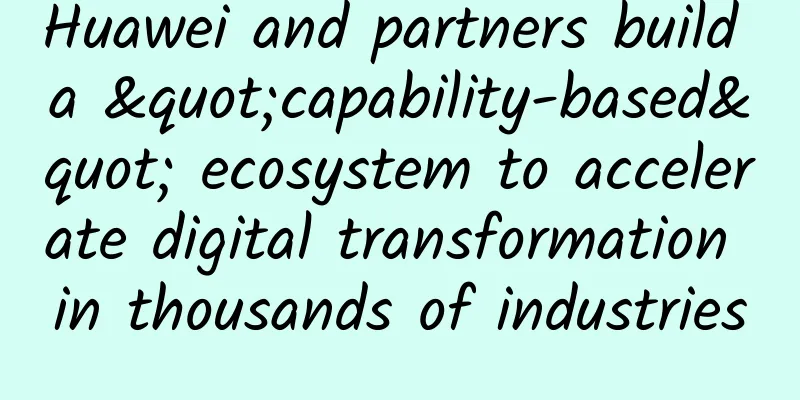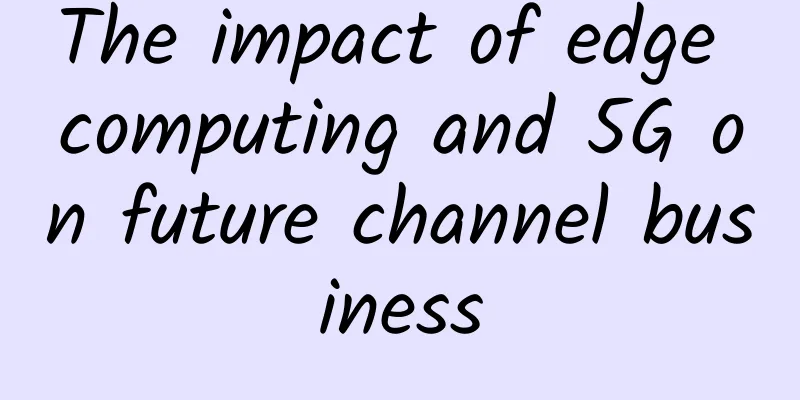Huawei and partners build a "capability-based" ecosystem to accelerate digital transformation in thousands of industries

|
[51CTO.com original article] From "0 to 1, 1 to 3, 3 to N", the process of digital transformation continues to accelerate in thousands of industries. At the "Huawei China Ecosystem Conference 2021", Huawei once again emphasized the strategy of adhering to "being integrated" and regarded "total integration" as one of the important capabilities to solve the digital transformation needs of various industries. We look forward to working with more partners to advance capabilities and create a new value ecosystem in the intelligent era.
Faced with the increasing and complex demands for digital transformation in various industries, how can Huawei find more "capable" partners such as general partners? How can partners work with Huawei to achieve win-win results? Regarding these questions, Yang Wenchi, Vice President of Huawei's China Government Business, Tian Ding, President of Huahai Smart Business, and Chen Yingzi, Senior Vice President of Beiming Software, gave detailed answers in their communication with the media. Working with partners to build a "capability-based" ecosystemAs the pace of digitalization in the industry accelerates, the needs of government and enterprise customers are also driving Huawei to make changes. "By 2017-2018, projects such as Smart Longgang, Shenzhen Airport, and some smart new districts appeared one after another. Customers have funds and basic needs, and the content to be achieved is not difficult on the surface, such as pulling data together and realizing smart office... But when you break it down, it is not simple. Huawei needs to sort out the needs and find corresponding solution partners to complete the capabilities." After being deeply involved in several projects, Huawei found that it was difficult to focus on improving its own capabilities in the long run, so it began to look for more capable "overall" partners. This not only ensured professional and timely project delivery, but also enabled Huawei to focus on things it was better at, such as offerings, and provide better solutions. "The centralization partner is very important in the future digital transformation scenarios. But we found that finding a centralization partner is much more difficult than finding a general agent in the past when we were selling traditional boxes." Yang Wenchi said, so Huawei will also focus on the capacity building of centralization partners in the next stage. Specifically, we first establish cooperation capability standards, a cooperative business model, and a scientific profit distribution model with general partners; and then, based on this, we gradually cultivate general partners that are qualified, capable, willing, and powerful in each segmented scenario. However, Huawei also needs to expand its influence, ensure customers’ high satisfaction with Huawei-delivered projects, and enhance the competitiveness of its own offerings in order to create more solutions and capabilities that meet customer needs.
Complexity is a characteristic of integrated projects. Complexity is reflected in business models, overall planning, and solution creation. In particular, the entire delivery process can be described as quite complex, with many uncertainties. Yang Wenchi said that in the face of customers' complex digital transformation needs, partner capability upgrades are even more important. In the past two or three years, Huawei has been "fighting while building capabilities." Together with ecological partners, we help partners improve their capabilities in actual combat and grow together. As we enter a new digital era, the market is changing rapidly. Therefore, in the face of many uncertainties in the future, Huawei will build an "ecological collaboration" cube and establish certain ecological capabilities to "respond to changes with constancy." "There is a house, the roof is digital transformation, and the pillars supporting the whole house are various capabilities, including investment and financing, security, service, sales, integration, solutions, consulting and planning..." Yang Wenchi described. To this end, Huawei also motivates ecological partners from multiple dimensions through rule-making, talent cultivation, profit distribution, etc., to help accelerate the digital transformation and upgrading of the industry and jointly open up new market space. In the vertical dimension, "upward" we will build industry digital scenario innovation through capability partners (consulting/integration/solutions). "Downward" we will increase cooperation with city partners (OC/distribution) to jointly expand the long-tail space. In 2020, Huawei's revenue from cities exceeded 30 billion, and it is expected that by 2024, the revenue from cities will exceed 150 billion. Yang Wenchi said that in the next 3-5 years, cities will continue to be a very important market for Huawei. Huawei currently has city general managers in 140 cities to complete customer coverage and demand insights. In the "horizontal" dimension, through the construction of the talent ecosystem, we will open up the "knowledge-skills-capacity" talent supply chain, inject a steady stream of ICT talents into the ecosystem partners, and enrich the "black soil" of talents. At the same time, through investment and financing partners, we will provide financial and operational support for digital transformation projects. In the "time" dimension, we will escort the ecosystem through the continuous construction of the e+ digital platform and the maintenance of the "sunshine, transparency, fairness and justice" ecological order. Continuously optimize and upgrade to improve the cooperation and collaboration efficiency between Huawei and its partners.
Regarding working with Huawei to jointly build a "capability-based" ecosystem , Chen Yingzi said that as one of the representatives of the general integration partners, Beiming has not only expanded the business market, but also exerted its own experience and skills in the system integration industry. From product integration to joint solutions, and then to today's integration stage, under Huawei's business strategy of "being integrated", the cooperative relationship between Beiming and Huawei has become closer, gradually forming an integration capability and business advantage of "1+1>2". At present, Beiming has built many industry solutions based on Huawei's digital platform and cultivated a mature technical team and sales team that understands Huawei's products and solutions. This also proves that Huawei has truly achieved common capabilities and symbiosis and win-win results in promoting its partners. As for how to divide the work with Huawei and make progress together , Tian Ding said that giving full play to each other's advantages and forming complementary capabilities is a basic principle in the overall project. The project can be roughly divided into three stages: Huawei usually takes the lead in top-level design in the pre-sales stage. This process requires the input of resources and capabilities from all aspects, including not only Huawei's own products and offerings, but also the integration partners and other third-party partners who understand the customer's business, to jointly develop a complete top-level design plan. The second stage is from project operation to bidding. Huawei is responsible for overall control of the architecture at this stage to ensure that the design plan meets customer needs. The general partner is responsible for leading the third-party partners to gradually meet customer needs. In the final delivery phase, Huawei is mainly responsible for guidance and direction, while the general partner is responsible for specific implementation, including project managers, solutions and other comprehensive project team members. If the customer has maintenance and operation needs, the general partner will use the corresponding tools and methodologies provided by Huawei to provide customers with corresponding localized teams for continuous service. We will forge ahead and achieve win-win results together. Facing the new opportunities and challenges of digital transformation in thousands of industries in the future, only by working together can we ride the wind and waves. We believe that with the close cooperation between Huawei and many integrated partners, we will create more new value for future digital transformation. [51CTO original article, please indicate the original author and source as 51CTO.com when reprinting on partner sites] |
<<: Borei Data reshapes APM and sets a new benchmark for IT operations and maintenance
Recommend
The United States suddenly changed its mind and allowed Huawei to cooperate in formulating 5G standards, only to shoot itself in the foot because of the Entity List
This article is reprinted with permission from AI...
How small businesses will benefit from 5G
Before enough new devices enter the mainstream ma...
Is this another money-making game? Why are you urging me to switch to 5G when 4G is so good?
At present, the number of 4G users in my country ...
Ruijie's all-scenario cloud desktop leads the new trend of Internet medical development
At present, affected by the epidemic, Internet me...
The cloud also needs its own network. The existence of SDN and VPC
If cloud computing is compared to water resources...
Why 5G Private Networks Are Critical to Enterprise Digital Transformation
Today’s enterprise manufacturing facilities are u...
5G and the Internet of Things: What does it mean for the telecommunications industry?
Today, in the telecommunications sector, 5G and I...
V5.NET: Hong Kong CN2 server limited 30% off, dual-channel E5 monthly payment starts from 625 yuan
V5.NET is offering a limited promotion for the HK...
Saving 5G, starting with removing the pull-down 5G switch?
Recently, many users have found that the 5G signa...
5 Mac software that are so useful that you don't want to share them, each of them is a representative of black technology
[[385059]] I have shared a lot of Windows compute...
5G Network as a Service (NaaS): How 5G enables telecom operators to monetize their networks
5G provides a large number of new applications fo...
How far will eSIM cards go in 2018?
The eSIM card was mentioned as early as 2011. The...
CloudCone: $17.99/year KVM-1GB/50GB/1TB/Los Angeles MC Data Center
CloudCone sent an email at the beginning of the m...
New electromagnetic wave router will enable unlimited bandwidth
UCLA researchers, with support from the Defense A...
Analyst: Open source is more likely to solve problems in the telecommunications industry
A senior consultant in the telecommunications ind...





![[Black Friday] spinservers: $49/month - E3-1280v5, 32G memory, 1TB NVme, 10Gbps bandwidth, San Jose/Dallas data center](/upload/images/67cabcf402984.webp)



